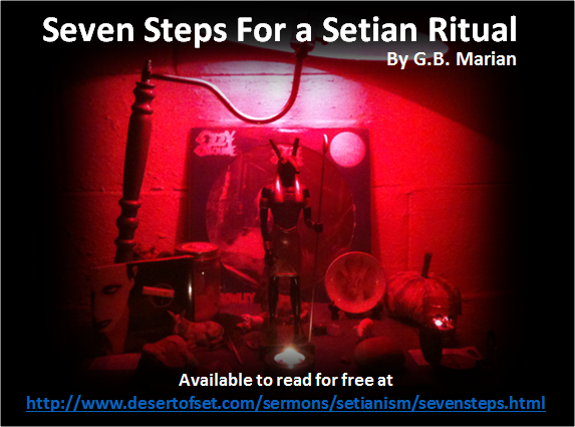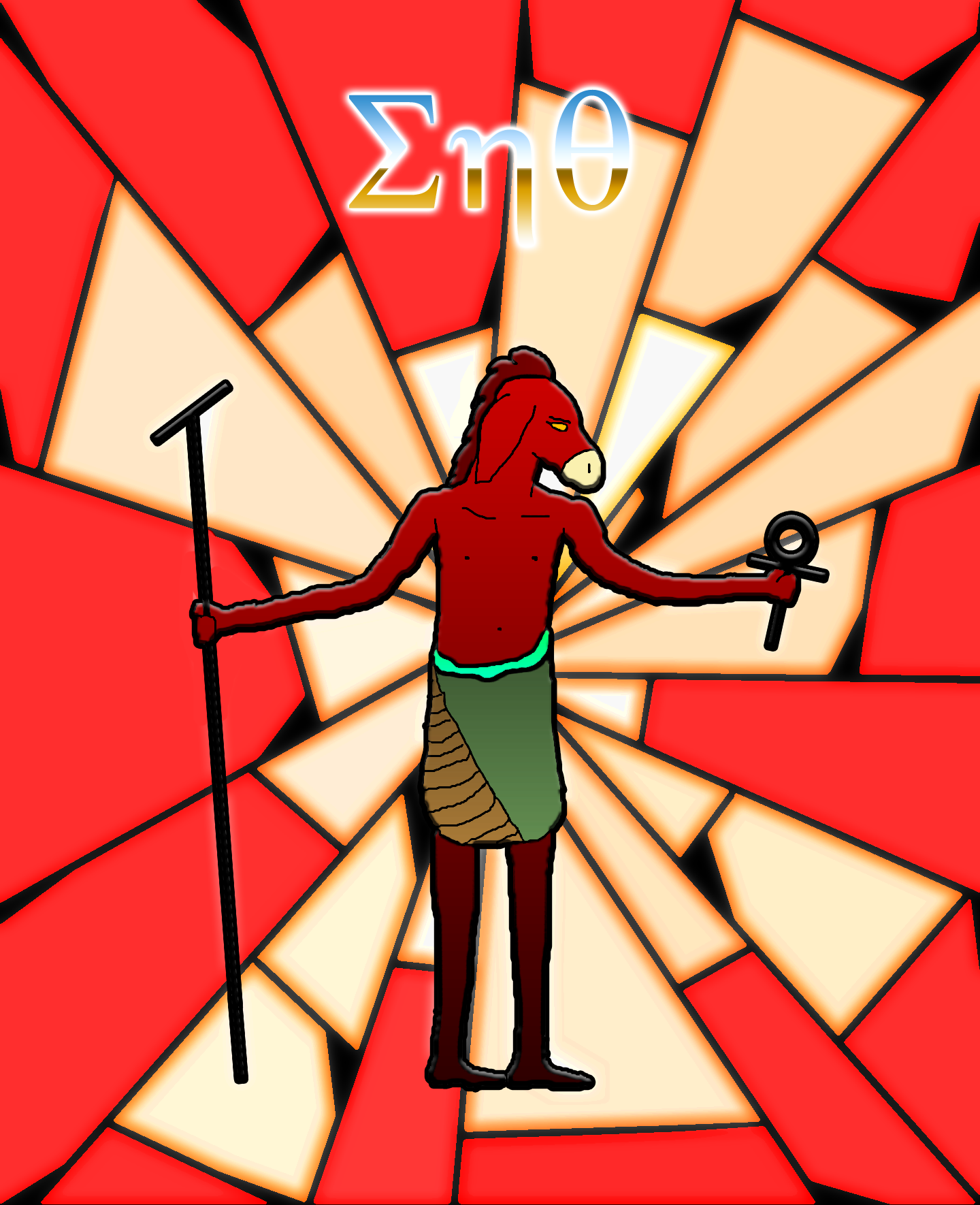

Being Setian doesn’t necessarily mean that you practice the ancient Egyptian religion. Certainly this is the case for those who also happen to be Kemetics, or Pagans who work to reconstruct the Egyptian religion as it was actually practiced in history. But there are also Setians who are more eclectic and who take their inspiration from things like Hermetic Qabalah, the Enochian Keys, or European witchcraft. This only makes sense, given that Set’s jurisdiction includes everything that was foreign to the Egyptian way of life. His followers were known for incorporating Libyan, Mesopotamian, Judaic, Gnostic, and Hermetic influences into His worship. Nowadays, Setians can even be influenced by Friedrich Nietzsche, Aleister Crowley, or H.P. Lovecraft for goodness’ sake. It doesn’t really matter, for there are really only two things that make someone a Setian in my opinion, and they are as follows:
A profound sense of self-identification with Set.
A devout commitment to your own self-determination in life.
Item #1 can cover a wide variety of perspectives. Perhaps you believe Set is an actual preternatural intelligence that acts upon the physical universe in ways we’re just not scientifically developed enough to understand yet. Perhaps when you invoke Him, you believe you’re addressing an actual being that exists apart from your own imagination. Or, perhaps you think Set is nothing more than a symbol; perhaps He just stirs a profoundly emotional response in you. Perhaps when you invoke Him, you see what you’re doing as a kind of mental “sleight-of-hand” that’s useful for helping you process things that are happening in your life. Or, perhaps you alternate between both of these perspectives depending on whatever you’re experiencing at any particular moment in time. I’ve been a Setian for more than two decades now myself, and I can honestly say I’ve run the gamut between these possibilities. I understand and accept both perspectives as being valid, and proponents of both are welcome at any circle I cast.
Item #2 is especially important, because it explains the Setian attitude in a nutshell. I have never met a Setian who believed that Set has a bunch of strict-ass rules He wants them to follow, or who thought they would be punished by Him if they didn’t follow said rules. This is because Set is not some authoritarian shepherd god who gets his jollies from herding the masses like livestock; He clearly prefers to piss off (or even terrify) such deities, and to pick fights with horrific chaos monsters at the same time. You don’t tell someone like that what to do, and you don’t exactly get instructions from them either. The way I see it, Set demands self-determination from His followers, not blind obedience. You don’t worship Him by groveling, remaining chaste, or otherwise harming yourself or anyone else “for Him.” Nor do you worship Him by “submitting” to His Will, or to anyone else’s for that matter. Being a Setian means that your will and Set’s are really one and the same. It means that your autonomy is absolute, and that you will defy anyone or anything that tries to dispossess you of your mind, body, or soul (whether it’s a god, a demon, or another human being). This is not a religion for the meek or the mild (nor for those who would fleece them), but for the proud and rebellious. And as the lone prophet of Set in his or her own life, the individual Setian has total freedom to choose or even create their own scriptures, rituals, holidays, etc.
That being said, there is no prescribed way for Setians to believe or practice. What makes us Setian is the simple fact that we have Set, and that we determine ourselves. That’s all there is to it. And though I have taken apprentices (each of whom has long since been recognized as a priest), it’s actually impossible to “teach” anyone how to be Setian. It’s always helpful to learn about other people’s ideas on the subject, but you are the one who must decide how you’re going to do things in the end.
In my walk with Set, I have developed my own methodology for rituals, which can be explained as having seven steps. These steps are not intended to be lauded as “dogma” by anyone, but are offered here as a starting point for newcomers who have no idea how to even begin. I have used these steps while teaching my students, and they in turn have used these steps to develop their own methodologies that differ from mine. It is my hope that someone else out there might find these steps helpful in much the same way.

1. Prepare your ritual space.
This procedure can be followed indoors or outdoors. Your altar can be any elevated surface (a table, tree stump, etc.), and it should have at least have one red candle and one image of Set. (This image can be as posh as an actual statue, or as simple as a doodle on notebook paper.) The altar should also be situated so that when you stand in front of it, you are facing north, toward the Big Dipper.
2. Observe a moment of silence.
After lighting your red candle, you should stand or sit still and be quiet for a while before you proceed. Your moment of silence should last for at least two minutes or so (five minutes at most).
3. Recite an invocation to Set.
Facing north, close your eyes and raise your arms into the sign of the Ka:

Then recite an invocation like this one:
Mighty TYPHON, from behind the Bull’s Thigh!
You who make the thundering winds to cry!
You who make the trembling earth to sigh!
You who make OSORONNOPHRIS to die!
Look upon me with Your fathomless Eye,
And greet me as Your friend and ally!
IO TYPHON ABERAMENTHO!
IO TYPHON ABLANATHANALBA!
IO PYTHON OPHION PAKERBETH!
IO SABAOTH SETH CHREPS!
(If you would like to hear someone else recite this invocation, a recording is available for playback at the bottom of this page.)
After invoking Set, make the sign of the Corna with your left hand:

Now with the same hand, trace a horned pentagram in the air before you, like so:

While tracing the final line, shout:
Then raise your arms back into the sign of the Ka and say:
4. Observe another moment of silence.
Feel the night come alive and the darkness sizzle with black heat. As you gaze at the image of Set upon your altar, take a moment to reflect on the fact that you are now gazing into a magical mirror, and that you are but a single head upon the hydra that is Set.
5. Articulate the purpose of the ritual.
Whether it’s to invoke good tidings, to ward off misfortune, or to mark an important occasion (a holiday, wedding, or funeral), this is the point where you state your will to Set. There is no standard format for this part of the procedure; it must be improvised and stated in your own words.
6. Make an offering to Set.
When it comes to offerings of food, almost all of Set’s sacred animals are vegetarians, so I recommend only vegetarian options. Anything with lettuce or watermelon will work nicely, and red wine is a natural choice for libations. Other acceptable offerings include cigars, red shiny things, iron objects, or even things you’ve created yourself. (My sister in Set once knitted Him a very lovely shawl.) Keep in mind that we don’t burn our offerings or leave them outside to rot like some people do; we dedicate them to Set, and then we put them to their proper use. If it’s food or drink, ingest it; if it’s some kind of shiny thing, add it to your altar; if it’s a shawl, wear it. The best offerings are those that can be shared.
7. Recite the closing litany.
Once the offering has been shared, it’s time to close the ritual. Other traditions end their workings with “banishings,” whereby they allegedly send away the Powers they’ve activated. We think it’s rude to call up a distinguished guest and then give Them the boot as soon as you’re done with Them. If you’re going to call on Set whenever you like, He has every right to call on you whenever He likes too. If the idea of not “banishing” Him when you’re done bothers you, then you shouldn’t be invoking Him in the first place. I’ve provided an example of a closing litany that we use here.
Great SET,
O mighty Red God!
Homage to You,
O Lord of the Wilderness,
O Divine Foreigner,
O Bringer of Storms,
O Savior of the Sun.
We acknowledge many gods,
But You are the Greatest,
Even greater than Osiris,
Even greater than Ra.
We thank You for Your audience,
And we close now this ritual.
May we make You proud
As we walk upon this Earth.
DUA SUTEKH!
